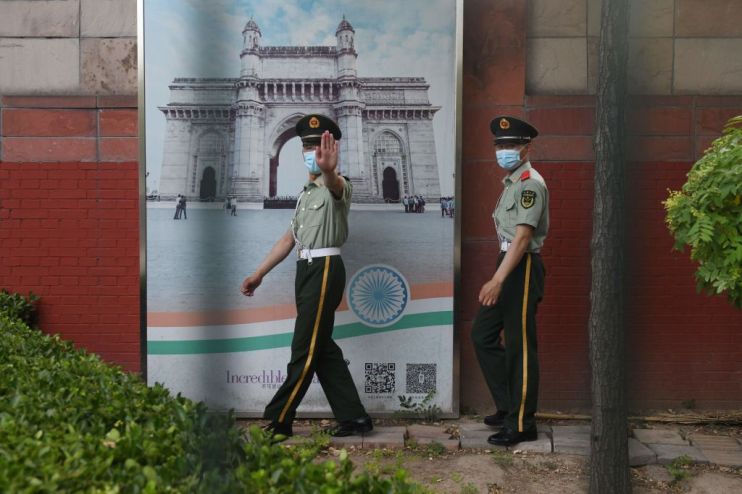With the rest of the world distracted, China is on the march across Asia

There are iron-clad geopolitical rules as to how the world works, edicts no less true because they are unknown by the vast majority of people.
The vastly underrated Nicholas J. Spykman, the foremost US strategic theoretician of the twentieth century, was a primary articulator of these secret runes.
As Spykman postulated, the underlying rules to global politics are based primarily on geography. The joint Eurasian supercontinent remains the dominant geographic fixture of the planet, in terms of resources, population, and overall importance. To control either section of Eurasia proper (Europe or Asia) is to dominate the world.
Unlike most American leaders, the Chinese Politburo have read their Spykman. They know that the key to emerging as the dominant power in the world is to control the vast Eurasian landmass, just as they know that if the US stops them from doing so it will retain its hegemonic position.
This basic geopolitical reality explains why China is presently on the march in Asia, taking advantage of an America preoccupied by the aftermath of the pandemic and nationwide protests.
The Belt and Road Initiative (BRI), begun by Chinese Paramount Leader Xi Jinping in 2013, amounts to a thinly-veiled effort over time to economically and then politically dominate the supercontinent in a manner that Spykman would instinctively have understood.
BRI is the umbrella programme for grand infrastructure and investment projects, economically binding Eurasia to Beijing through a series of land and maritime corridors. Presently, BRI comprises 2,631 mostly ongoing development projects, totalling a massive $3.7 trillion.
As was true with the brilliant US-inspired Marshall Plan after World War II, BRI is an effort to bind alliances through the glue of common economic interests. China hopes over time to coherently link a dominant Eurasia into a China-centric economic sphere, one which would be the preponderant force in the world.
There is also a second, more immediately coercive, element to BRI: it serves as a snare for trapping weak states into becoming mendicants of Beijing.
For example, in 2017, China extracted a 99-year lease for the management of Hambantota, the principal port of Sri Lanka, in exchange for a desperately needed $1.1bn, in what basically amounted to a debt for equity swap.
That year, 95 per cent of the Sri Lankan government’s revenue went towards debt servicing, making it utterly dependent on Beijing. In handing over its main port, a hapless Sri Lanka has become part of China’s overall “string of pearls” strategy in the Indian Ocean (ironically modelled on the British Empire’s strategic doctrine) designed to hem in rising rival India.
And it is not just economically that China is throwing its weight around in Asia. Patently ignoring the unambiguous legal ruling of the UN international court in The Hague, Beijing has aggressively pressed its territorial claims in the South China Sea, maintaining its right to sovereignty over 90 per cent of the waterway, based on the spurious “Nine-dash line”.
Just since the start of this year, Beijing has been involved in fraught maritime incidents with Indonesia, Malaysia, and Vietnam. Constructing a series of new islands, as well as fortifying natural features, Beijing has quickly equipped its island territories with radar systems, fighter jets and anti-submarine aircraft.
China can never dominate Asia if it cannot dominate the seas that surround it. That is what it is presently attempting to do.
President Xi has now struck at the other end of his far-flung empire, provoking a border dispute with India, largely because that great power rival is diplomatically moving ever closer to the US
In May, China’s People’s Liberation Army crossed the Line of Actual Control (LAC) in three places, the unofficial border demarcating the China-dominated Aksai Chin region from Indian-controlled Ladakh in the Himalayas.
In the ensuing confusion, two border patrols ran into each other high above the Galwan River on a moonless night this past week. Some 600 men fought for up to six hours with little more than sticks, their fists, and iron bars. In the end, at least 20 Indian soldiers were killed, leaving China in possession of the just- seized Galwan River Valley.
But here, perhaps, Freud is needed rather than Spykman. For Xi and his Politburo cronies do not seem to know much about human nature.
Far from being cowed, India’s nationalist Modi government is accusing China of “premeditated and planned” actions high in the Himalayas. It is unlikely to back down. Indeed, China’s bullying (as in the South China Sea) is more likely to throw these hard-pressed Asian countries into America’s arms.
China is on the march. Its geostrategic strategy is highly sound. But its misunderstanding of how humans actually react may well be its downfall.
Main image credit: Getty